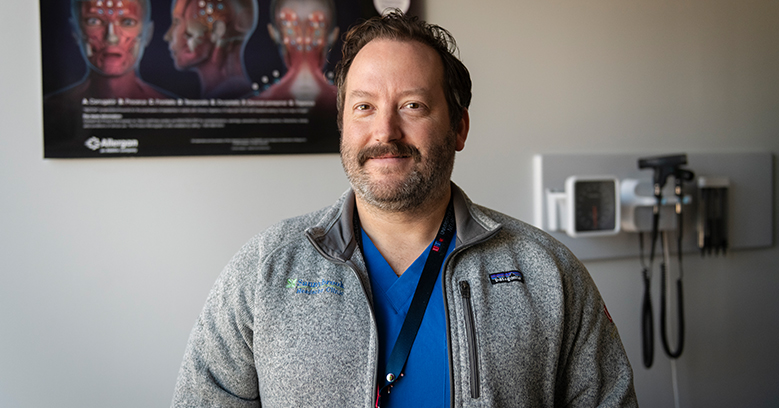Migraine and headaches are a common condition that most people will experience several times throughout their life. They are the most common neurological disorder, and the number one reason for a referral to a neurologist, but did you know that there are over 150 different types of headaches? Not all headaches cause the same pain or symptoms, or are treated the same.
This Migraine and Headache Awareness Month, we spoke with Dr. William Kingston, neurologist and director of the Sunnybrook Headache Clinic, to learn more about the symptoms and causes about “the big three” types of headaches and advice on when to seek help.
Tension headaches
A tension headache is the most common type of headache, in that everyone you know, including yourself, has experienced at some point. It is a mild to moderate, non-debilitating headache that usually doesn’t have any other symptoms, like nausea or sensitivity to light, associated with it. Tension headaches are typically a rare reason to go to the doctor.
Tension headaches and migraine are both what we call a primary headache disorder, which means there isn’t an underlying cause that can be seen on a laboratory test or scan.
Migraine
Migraine is the most common reason someone would seek medical attention for a headache. It is also the most common reason you may have a disability associated with a headache. The World Health Organization has recognized migraine as being the second most debilitating condition that exists in terms of years lived with the disability, because migraine can affect people their whole life.
Migraine affects about 12-15 per cent of the population and make up for approximately 10 per cent of primary care and emergency room visits. Despite this, it may take years for someone to receive a migraine diagnosis, with some people actually never receiving one.
Migraines feel different for different people. A migraine could be a headache that lasts up to four hours, and severe enough that it interrupts your daily activities or causes sensitivity, nausea or a loss of appetite. Some people might experience these symptoms every day, others a handful a year. People who suffer from migraine might also develop an aura, which means they might experience visual symptoms like seeing spots. In the hours or days leading up to a migraine, people might experience prodrome, which are symptoms like neck pain, certain food cravings or increased urination.
One of the biggest misconceptions of migraine is that it is a result of a lack of self-care. Migraine is an inherit neurological disease that is influenced, but not caused by of poor self-care. Migraine is a condition that loves routine. Maintaining regular sleep patterns, adequate hydration and exercise has been shown to be really beneficial for people with migraine. It’s not going to be a cure, but it may improve your chances of managing migraine.
Cluster headaches
Cluster headaches are typically shorter, and happen multiple times, or in clusters, every day. These types of headaches occur usually exclusively on one side of the side of the head, behind the eye and around the temple. Cluster headaches are sometimes also referred to as alarm clock headaches, because they may appear at the same time of day or year, so people might be able to predict when a cycle of headaches might start.
Cluster headaches have been described as being the most painful condition known to human beings on a pain scale. This can also have significant implications on mental health, as the unmanageable pain interferes with daily living.
Those suffering from cluster headaches receive a diagnosis in an average of five years. Part of this is because cluster headaches have longer periods of reprieve, so by the time they receive care from a specialist, the headaches are gone until the cycle later repeats itself.
When should I seek help for headaches?
Headaches are an extremely common conditions and many times not a cause for concern, but there are a few “red flags” doctors look out for. If you are someone that has never experienced headaches, especially if you are over the age of 40, and have suddenly developed headaches, reach out to your family doctor or general practitioner. You should also seek help if you experience brand new headaches that wake you from sleep.
Thunderclap headaches are another “red flag” that doctors warn about. These headaches are sudden, painful headaches that reach peak intensity in under a minute. If your headaches are accompanied by other symptoms like fever, nausea, blurred vision or weakness, then it’s time to seek medical attention.
More patient resources and awareness:








